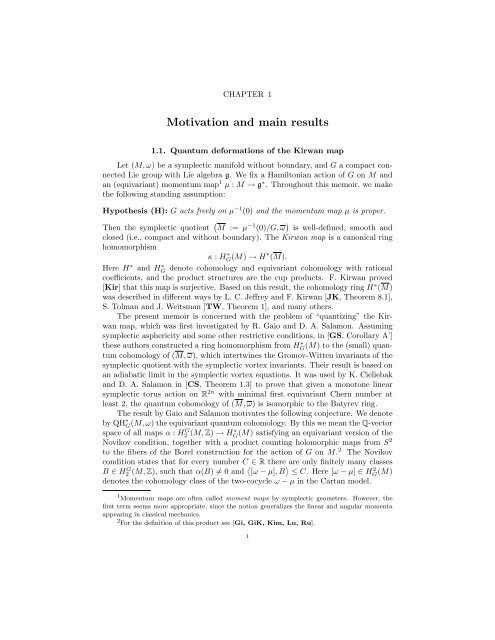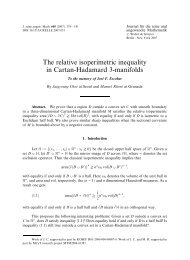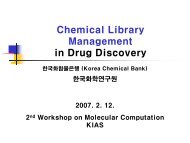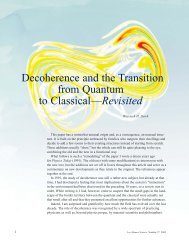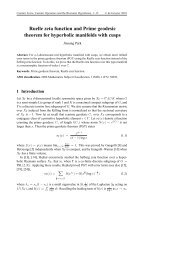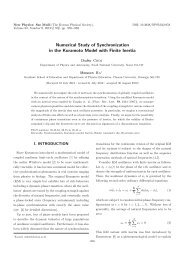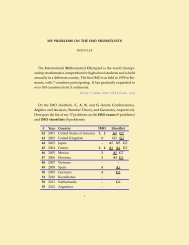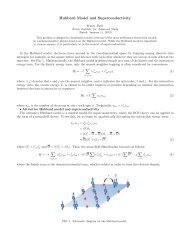A Quantum Kirwan Map: Bubbling and Fredholm Theory for ... - KIAS
A Quantum Kirwan Map: Bubbling and Fredholm Theory for ... - KIAS
A Quantum Kirwan Map: Bubbling and Fredholm Theory for ... - KIAS
You also want an ePaper? Increase the reach of your titles
YUMPU automatically turns print PDFs into web optimized ePapers that Google loves.
CHAPTER 1Motivation <strong>and</strong> main results1.1. <strong>Quantum</strong> de<strong>for</strong>mations of the <strong>Kirwan</strong> mapLet (M,ω) be a symplectic manifold without boundary, <strong>and</strong> G a compact connectedLie group with Lie algebra g. We fix a Hamiltonian action of G on M <strong>and</strong>an (equivariant) momentum map 1 µ : M → g ∗ . Throughout this memoir, we makethe following st<strong>and</strong>ing assumption:Hypothesis (H): G acts freely on µ −1 (0) <strong>and</strong> the momentum map µ is proper.Then the symplectic quotient ( M := µ −1 (0)/G,ω ) is well-defined, smooth <strong>and</strong>closed (i.e., compact <strong>and</strong> without boundary). The <strong>Kirwan</strong> map is a canonical ringhomomorphismκ : HG(M) ∗ → H ∗ (M).Here H ∗ <strong>and</strong> HG ∗ denote cohomology <strong>and</strong> equivariant cohomology with rationalcoefficients, <strong>and</strong> the product structures are the cup products. F. <strong>Kirwan</strong> proved[Kir] that this map is surjective. Based on this result, the cohomology ring H ∗ (M)was described in different ways by L. C. Jeffrey <strong>and</strong> F. <strong>Kirwan</strong> [JK, Theorem 8.1],S. Tolman <strong>and</strong> J. Weitsman [TW, Theorem 1], <strong>and</strong> many others.The present memoir is concerned with the problem of “quantizing” the <strong>Kirwan</strong>map, which was first investigated by R. Gaio <strong>and</strong> D. A. Salamon. Assumingsymplectic asphericity <strong>and</strong> some other restrictive conditions, in [GS, Corollary A’]these authors constructed a ring homomorphism from HG ∗ (M) to the (small) quantumcohomology of (M,ω), which intertwines the Gromov-Witten invariants of thesymplectic quotient with the symplectic vortex invariants. Their result is based onan adiabatic limit in the symplectic vortex equations. It was used by K. Cieliebak<strong>and</strong> D. A. Salamon in [CS, Theorem 1.3] to prove that given a monotone linearsymplectic torus action on R 2n with minimal first equivariant Chern number atleast 2, the quantum cohomology of (M,ω) is isomorphic to the Batyrev ring.The result by Gaio <strong>and</strong> Salamon motivates the following conjecture. We denoteby QH ∗ G(M,ω) the equivariant quantum cohomology. By this we mean the Q-vectorspace of all maps α : H2 G (M, Z) → HG ∗ (M) satisfying an equivariant version of theNovikov condition, together with a product counting holomorphic maps from S 2to the fibers of the Borel construction <strong>for</strong> the action of G on M. 2 The Novikovcondition states that <strong>for</strong> every number C ∈ R there are only finitely many classesB ∈ H2 G (M, Z), such that α(B) ≠ 0 <strong>and</strong> 〈 [ω − µ],B 〉 ≤ C. Here [ω − µ] ∈ HG 2 (M)denotes the cohomology class of the two-cocycle ω − µ in the Cartan model.1 Momentum maps are often called moment maps by symplectic geometers. However, thefirst term seems more appropriate, since the notion generalizes the linear <strong>and</strong> angular momentaappearing in classical mechanics.2 For the definition of this product see [Gi, GiK, Kim, Lu, Ru].1


